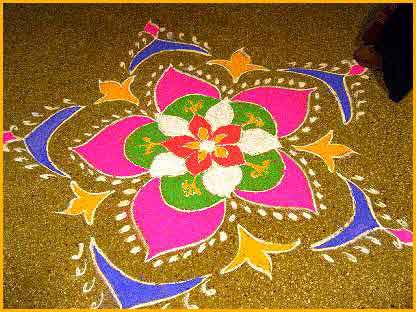It is believed by many that duringDiwali, Goddess Lakshmi visits homes that are well lit, so families decorate their homes, people wear their best clothes, children are given presents and new year greetings are exchanged through visits or Diwali cards.
An important part of the celebrations is Rangoli which is created on doorsteps to welcome everybody. Rangoli exudes a pattern in color that are specific for each region.
In the art of floor painting, the central rangoli design is the symbolic one denoting the deity or the theme. Though the designs vary in different sections of India, the basic approach is common. The designs are geometric and proportioned. Also, Rangoli can be made in two ways - dry and wet.
An important part of the celebrations is Rangoli which is created on doorsteps to welcome everybody. Rangoli exudes a pattern in color that are specific for each region.
In the art of floor painting, the central rangoli design is the symbolic one denoting the deity or the theme. Though the designs vary in different sections of India, the basic approach is common. The designs are geometric and proportioned. Also, Rangoli can be made in two ways - dry and wet.

Motifs include lotus, fish, birds etc which reflects the unity of man and beast. Most of the rangoli designs are circular exuding a sense of endlessness of time. Sun, moon and other zodiac signs are also common themes for rangoli besides Om, mangal kalash, swastika, chakra, a lighted Deepak, trident, shree, lotus etc.
The raw materials mainly used to make rangoli include edibles like rice flour, pulse and leaves. Earlier, the colors were traditionally derived from natural dyes but today, however, synthetic dyes are used in a range of bright hues. Other materials include colored sand and even flowers and petals, as in the case of Flower Rangolis.
It has been a tradition in India to draw Rangoli on the festivals and other auspicious occasions as it is considered a holy ritual.
 India is famous for its rich culture and traditions. So much so that each state even has its own language, cuisine, festivals, culture and traditions! If you live in one state, you may not know about the folk art of another; they're passed on from generation to generation.
India is famous for its rich culture and traditions. So much so that each state even has its own language, cuisine, festivals, culture and traditions! If you live in one state, you may not know about the folk art of another; they're passed on from generation to generation.Rangoli is one such tradition. It is very popular in most of the Indian states. Rangoli has different names from state to state. In southern India, it is known as Kolam; in eastern India, it is called Alpana.

As a child, I was always drawn to this beautiful art form. I delighted in seeing women folk decorating the entrance of their homes with Rangoli designs and patterns. I have been always a lover of art, color,designs and things which are creative. Over the years, my fascination for rangoli and rangoli designs has be
come stronger and now I also make sure that Idraw rangoli when we celebrate Diwali. Even my son loves helping me out in my designs!
This lens is about Rangoli Kolam Designs and how to make free hand Rangoli or Kolam designs and patterns. It is my pleasure to share this beautiful art form from India with other parts of the world. I will be happy if my lens sparks your interest a little too!
Click Here....
Get More Traffic...
This lens is about Rangoli Kolam Designs and how to make free hand Rangoli or Kolam designs and patterns. It is my pleasure to share this beautiful art form from India with other parts of the world. I will be happy if my lens sparks your interest a little too!
Click Here....
Get More Traffic...
 6:44 AM
6:44 AM
 sWeEt RoSe
sWeEt RoSe




0 comments:
Post a Comment